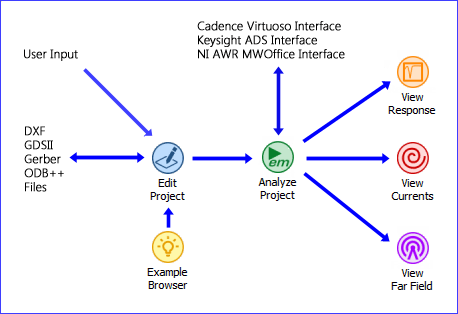The suite of Sonnet analysis tools is shown below. Using these tools, Sonnet provides an open environment to many other design and layout programs. The following is a brief description of all of the Sonnet tools. Check with your system administrator to find out if you are licensed for these products:

Project Editor: The project editor is a user-friendly graphical interface that enables you to input your circuit geometry or circuit netlist for subsequent em analysis. If you have purchased the DXF and/or the GDSII translator, the translator interface is found in the project editor. You also set up analysis controls for your project in the project editor.
Program Module: xgeom
Analysis Engine: Em is the electromagnetic analysis engine. It uses a modified method of moments analysis based on Maxwell's equations to perform a true three dimensional current analysis of predominantly planar structures. Em computes S, Y, or Z-parameters, transmission line parameters (Z0, Eeff, VSWR, GMax, Zin, and the Loss Factor), and SPICE equivalent lumped element networks. Additionally, it creates files for further processing by the current density viewer and the far field viewer. Using Sonnet's netlist, em cascades the results of electromagnetic analyses with lumped elements, ideal transmission line elements and external S-parameter data. For more information about em, see the Sonnet User's Guide.
Program Module: em
Job Queue: The job queue allows you to observe the on-going status of analyses being run by em as well as creating and editing queues for em jobs.
Program Module: emstatus
Response Viewer: The response viewer is the plotting tool. This program allows you to plot your response data from em, as well as other simulation tools, as a Cartesian graph or a Smith chart.
Program Module: emgraph
Current Density Viewer: The current density viewer is a visualization tool which acts as a post-processor to em providing you with an immediate qualitative view of the electromagnetic interactions occurring within your circuit.
Program module: emvu
Far Field Viewer: The far field viewer is the radiation pattern computation and display program It computes the far-field radiation pattern of radiating structures (such as patch antennas) using the current density information from em and displays the far-field radiation patterns in one of three formats: Cartesian plot, polar plot or surface plot.
The Far Field Viewer is not available in version 17.52.
Program module: patvu
GDSII Translator: The GDSII translator provides bidirectional translation of GDSII layout files to/ from the Sonnet project editor geometry format.
Program module: gds
DXF Translator: The DXF translator provides bidirectional translation of DXF layout files (such as from Autocrat) to/from the Sonnet project editor geometry format.
Program module: dxfgeo
Gerber Translator: The Gerber translator provides bidirectional translation of Gerber layout files to/from the Sonnet project editor geometry format.
Program module: sonntgbr
ODB++ Translator: The ODB++ translator allows you to import an ODB++ archive or directory to the Sonnet project editor geometry format.
Program module: sonntgbr
Keysight ADS Interface: The Keysight ADS Interface provides a seamless translation capability between Sonnet and Keysight ADS. From within the ADS Layout package you can directly create Sonnet geometry files. Em simulations can be invoked and the results incorporated into your design without leaving the ADS environment.
Program module: ebridge
Cadence AWR Microwave Office Interface - Available only for PC.
The Cadence AWR Microwave Office Interface provides a seamless incorporation of Sonnet’s world class EM simulation engine, em, into the Microwave Office environment using Microwave Office's new EM socket. You can take advantage of Sonnet’s accuracy without having to learn the Sonnet interface. Although, for advanced users who wish to take advantage of powerful advanced features not presently supported in the integrated environment, the partnership of Cadence AWR and Sonnet has simplified the process of moving EM projects between Microwave Office and Sonnet.
Program module: sonntawr
Cadence Virtuoso Interface - Available only for Linux
This Sonnet plug-in for the Cadence Virtuoso suite enables the RFIC designer to configure and run the EM analysis from a layout cell, extract accurate electrical models, and create a schematic symbol for Analog Artist and RFDE simulation.
Program Module: sonntcds
A Broadband Spice extraction module is available that provides high-order SPICE models suitable for SPICE simulations. In order to create a SPICE model which is valid across a broad band, the Sonnet broadband SPICE feature finds a rational polynomial which "its" the S-Parameter data. This polynomial is used to generate the equivalent lumped element circuits which may be used as an input to either PSpice or Spectre. Since the S-Parameters are fitted over a wide frequency band, the generated models can be used in circuit simulators for AC sweeps and transient simulations. Sonnet has optimized these models to be causal by using only resistors, capacitors and inductors.
Program Module: bbextract
The Inductor Model Extractor (IME) feature allows you to extract an intuitive equivalent circuit model from the EM analysis of a spiral inductor. There are two topologies available for the IME: the “Untapped” model and the “Center Tapped” model. Both topologies generate a simple, physical, fixed-topology.
Program Module: bbextract